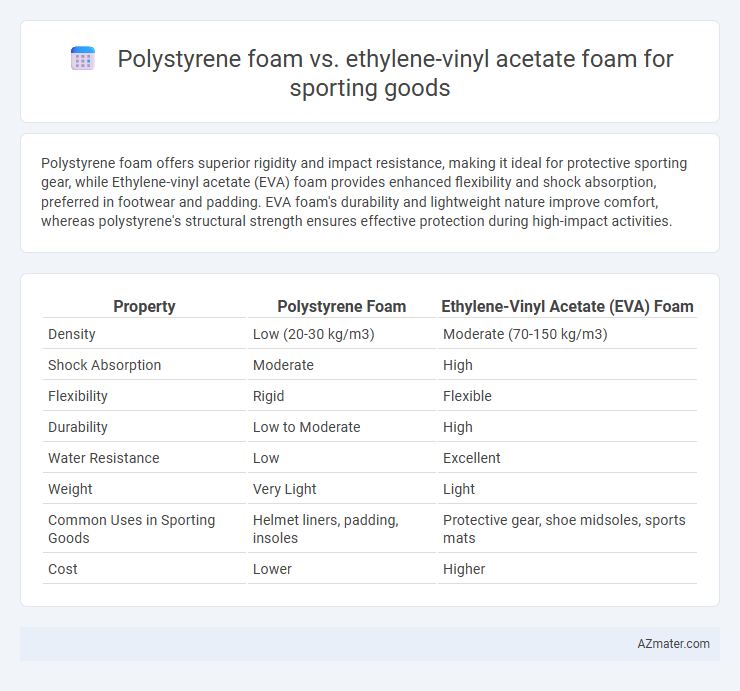Polystyrene foam offers superior rigidity and impact resistance, making it ideal for protective sporting gear, while Ethylene-vinyl acetate (EVA) foam provides enhanced flexibility and shock absorption, preferred in footwear and padding. EVA foam's durability and lightweight nature improve comfort, whereas polystyrene's structural strength ensures effective protection during high-impact activities.
Table of Comparison
| Property | Polystyrene Foam | Ethylene-Vinyl Acetate (EVA) Foam |
|---|---|---|
| Density | Low (20-30 kg/m3) | Moderate (70-150 kg/m3) |
| Shock Absorption | Moderate | High |
| Flexibility | Rigid | Flexible |
| Durability | Low to Moderate | High |
| Water Resistance | Low | Excellent |
| Weight | Very Light | Light |
| Common Uses in Sporting Goods | Helmet liners, padding, insoles | Protective gear, shoe midsoles, sports mats |
| Cost | Lower | Higher |
Introduction to Foam Materials in Sporting Goods
Polystyrene foam and Ethylene-vinyl acetate (EVA) foam are widely used materials in sporting goods due to their unique properties. Polystyrene foam offers high rigidity and impact resistance, making it ideal for protective gear like helmets and padding. EVA foam provides superior cushioning, flexibility, and shock absorption, commonly used in footwear midsoles and sports mats for enhanced comfort and performance.
Overview of Polystyrene Foam
Polystyrene foam is a lightweight, rigid material widely used in sporting goods for its excellent shock absorption and impact resistance, making it ideal for protective gear such as helmets and padding. Its closed-cell structure provides superior water resistance and durability, ensuring long-lasting performance in various sports environments. Compared to ethylene-vinyl acetate (EVA) foam, polystyrene offers greater stiffness and structural support, though it tends to be less flexible and cushioning.
Overview of Ethylene-Vinyl Acetate (EVA) Foam
Ethylene-Vinyl Acetate (EVA) foam is widely favored in sporting goods for its superior cushioning, flexibility, and impact absorption compared to polystyrene foam. EVA foam offers enhanced durability and resilience, making it ideal for protective gear, footwear midsoles, and padding in sports equipment. Its lightweight structure and resistance to cracking under stress ensure long-lasting comfort and performance in athletic applications.
Durability Comparison: Polystyrene vs EVA Foam
Polystyrene foam exhibits excellent rigidity and resistance to compression, making it ideal for protective sporting gear that requires structural support and impact absorption. Ethylene-vinyl acetate (EVA) foam provides superior flexibility, resilience, and cushioning, resulting in enhanced durability under repeated stress and deformation. While polystyrene foam is prone to cracking and losing integrity after extensive use, EVA foam maintains its performance with better shock absorption and longer lifespan in dynamic sports applications.
Impact Absorption and Cushioning Properties
Polystyrene foam offers excellent impact absorption due to its rigid cellular structure, making it ideal for protective sporting goods such as helmets and pads. Ethylene-vinyl acetate (EVA) foam provides superior cushioning properties with flexible, soft, and resilient material that enhances comfort and shock absorption in footwear and sports equipment. The combination of EVA's elasticity and Polystyrene's durability creates optimized protection tailored to different sporting demands.
Weight and Flexibility in Sports Applications
Polystyrene foam offers lightweight properties but lacks flexibility, making it less ideal for dynamic sports equipment that requires shock absorption and movement. Ethylene-vinyl acetate (EVA) foam balances low weight with superior flexibility, providing enhanced impact resistance and comfort in sporting goods such as shoe soles and protective gear. The combination of EVA's elasticity and cushioning makes it the preferred choice for applications demanding both durability and athlete mobility.
Environmental Impact and Recyclability
Polystyrene foam, commonly used in sporting goods for its lightweight and shock-absorbing properties, poses significant environmental concerns due to its non-biodegradability and difficulty in recycling, often ending up in landfills or marine environments. Ethylene-vinyl acetate (EVA) foam offers a more eco-friendly alternative with better recyclability options and lower environmental impact, as it decomposes more readily and can be repurposed into new products through established recycling processes. Choosing EVA foam reduces long-term ecological damage while maintaining the performance standards required in sporting goods applications.
Cost Analysis and Availability
Polystyrene foam offers a lower production cost and widespread availability, making it a cost-effective option for sporting goods such as protective padding and helmets. Ethylene-vinyl acetate (EVA) foam, while pricier due to its enhanced elasticity and durability, provides superior shock absorption and comfort, which can justify the higher expense in performance-focused applications. Market demand and regional manufacturing capacities influence the accessibility of both foams, with polystyrene being more abundant globally and EVA sometimes limited by its more complex production processes.
Typical Sporting Goods Applications
Polystyrene foam is widely used in sporting goods for its high rigidity and impact resistance, making it ideal for protective gear such as helmets and body armor. Ethylene-vinyl acetate (EVA) foam offers superior flexibility, shock absorption, and water resistance, which are essential in shoe soles, padding, and grips for enhanced comfort and durability. Both materials address different performance needs, with polystyrene foam excelling in structural support and EVA foam providing cushioning and resilience in active sports environments.
Recommendations and Final Considerations
Polystyrene foam offers superior rigidity and impact resistance, making it ideal for protective gear in high-impact sports such as cycling and skateboarding. Ethylene-vinyl acetate (EVA) foam provides enhanced flexibility and cushioning, suitable for footwear and padding in sports requiring agility and shock absorption. For optimal performance, select polystyrene foam in applications demanding structural support, while EVA foam is recommended where comfort and flexibility are prioritized.

Infographic: Polystyrene foam vs Ethylene-vinyl acetate foam for Sporting good
 azmater.com
azmater.com